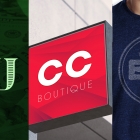How to Name Stuff: Tips for Successful Business Naming, Part 2
Last week we started this series by talking about how the name of your brand or product needs to reinforce the key elements you want to convey. We went over descriptive and meaningful names that clearly state what a business or product does. We also talked about names that are more abstract and tell a story about what the brand or product is about. Today, we’re going to talk about some current trends in naming. We’ll also touch on how to narrow down your list of potentials by making sure there’s a URL available with your name in it, and searching for other businesses that might be using that name already.
Naming Trendz n’ U!
You’ve probably driven down the street and noticed a ton of businesses using funky spellings, compound words, acronyms and made up words in an attempt to make them stand out. There are certainly some great trends in naming that businesses have found success using, but they all have their pros and cons. Let’s explore them a little bit.
1) Crazy spellings
Kidz Kutz, Play Playce, Gud Eatz. The list goes on and on as more and more businesses turn to alternative spellings for that “wow” factor. Even websites like Flickr, Digg, and Tumblr have used phonetics to give them a cool edge. The only downside to creative spellings is that it could be confusing or hard for folks to remember the spelling when searching online.
2) CompoundWords
You see this all the time these days, don’t you? Think about names like CoolStream, TeethFirst!, and Facebook. You can get your creative on big time by making up compound words. They’re great because they give you a chance to use two words to represent your business or product. The only caution we have here is not to get too creative and make a mashup of words that don’t make sense together.
3) Acronyms or initials
Some really extraordinary super cool businesses make great use of initials and acronyms. The GLAD WORKS name is actually initials and an acronym. GLAD represents Gina’s name: Gina Lisa Angelo DiSpirito. But, it also stands for Graphic Layout And Design. We capitalized the WORKS part for consistency. Betcha didn’t know that little fun fact about us. It’s an old school way of doing it, but it’s stood the test of time and shows no signs of slowing down! Rumor has it that even the Wall Street Journal is going to change their name to WSJ.
4) Pretend words
Making up your own word can be amazingly successful if you do it correctly. It’s not easy to pull off though. People might not get it, they might not be able to remember it or they might think it’s just plain stupid. If done well, it’ll give you a cool edge that’s very memorable, catchy and sets you way apart from everyone else.
Once you’ve got some possible names, you’re not done yet
Once you have your list of names written down, you’re not done yet. Now you’ve got to make sure no one else is using it so that you can secure a URL with the name in it. This isn’t as easy as it sounds. The URL part can be very tricky and might just be a deal breaker. It’s kind of a non-negotiable since your name really needs to be in your web address so that people can find you easily. Searching for a URL and checking to make sure nobody else is using your name might help you narrow down your choices.
Finding a URL
Funky spellings, compound words and made up words are great because they can help you sidestep the issue of securing a URL with your name in it. The more unique, the easier it will be to find a URL. If you’ve chosen to go with an acronym, the big setback you might encounter when searching for a URL is that most are only three letters long. We regret to inform you that there are no three letter URLs left on the Internet. Yup. They’re all sold out, so you may end up having to spell out what your acronym stands for instead. You could also try to buy the acronym from its owner.
You should also make sure you’re not stepping on any toes. You can search the U.S. Patent and Trademark Office website to see if your prospective name is already being used. You can also do a simple Google search.
Naming things is actually very hard to do. Give yourself some time. Think about it carefully and try to approach it from a consumer’s perspective. What might sound incredible and cool to you might turn them off or confuse them, so before making any commitments, test the name out on friends and family and consider their feedback. Most importantly though, have fun with this! It’s a creative endeavor that can have tremendous rewards!

 An agency-eye view of Marketing, Advertising, Branding, Design & Media.
An agency-eye view of Marketing, Advertising, Branding, Design & Media.




